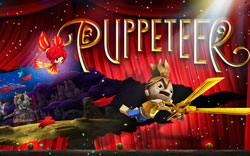It seems like “Puppeteer” couldn’t have been released at a worse time. With only a couple of months left before the new consoles release and the highest grossing videogame of all time on shelves, who would give the time of day to a quirky little game from Sony Japan? However, the novelty of running over pedestrians while listening to Queen only lasts so long. In order to fight off the tyranny of boredom, a hero needs to rise from the ashes of the giant that was the last console generation. “Puppeteer” is out there, fighting the good fight, and it is about time that it got the recognition it deserves.
“Puppeteer” is a side-scrolling action platformer with a unique twist: the game takes place inside a theatre. Curtains open and close as a scene begins or ends, the audience laughs at a joke or gasps at hair-raising moments and a brilliant narrator provides context to the story. A colorful group of characters are made more memorable by the fact that they are technically actors playing a role. Occasionally, they are too over dramatic and incite the other performers, get into quips with the narrator or forget their lines. While the humor is hit or miss, these moments help to cement the theatre setting.
The narrator is one of “Puppeteer’s” biggest triumphs. Narration is something rarely done in videogames due to the high amount of voice overs necessary. It takes a truly enthusiastic voice actor and elegant writing to pull off narration. He is used just enough, although there are occasions when he talks over the characters’ dialogue and it feels as if you are in a court room. Despite these minor shortcomings, the narrator is a welcome addition, allowing players to slice up foes while he feeds them context.
The player takes control of Kutaro, a young boy who has his soul stolen by the evil tyrant Moon Bear King. Within the opening scene of the game, Moon Bear King places Kutaro’s soul in a puppet and bites his head off, tossing him to the dungeon after his decapitation. From there, you are quickly introduced to the head system. Without a head, Kutaro is forced to use whatever is available. He starts off with a skeleton head, but it can range from anything as predictable as a pumpkin to as strange as a banana.
These different heads have a surprisingly insignificant impact on how Kutaro controls. They allow him to access shortcuts, bonus stages or extra items. The heads’ primary purpose is to gauge how much damage Kutaro can take. He can hold up to three heads at once, with each hit resulting in his beheading. Lose each head and the player must restart from the last checkpoint.
While it would’ve been nice to see the heads have more of an impact, they also work well as collectibles. Scavenging for hidden heads gives “Puppeteer” replay value. It does, however, leave you with the impression that Sony Japan had something more planned for this mechanic, but either ran out of funding or time.
The game is a slow roller. In the beginning, Kutaro hasn’t unlocked any of his abilities yet, and while the theatre context is fresh and engaging, it takes time to get comfortable there. At times there is too much going on. There will be narration, actors chatting, and the detailed environments all diverting your eyes from the monsters trying to kill you. In addition to the movements of Kutaro, the player is also given control over a companion (Ying-Yang in the beginning, Picarina later on) who can reveal hidden collectibles. The backdrops also transition so quickly that it can be difficult to track Kutaro’s location.
However, once Kutaro has gained new abilities and you become accustomed to the game, it begins to hit its stride. Kutaro and crew travel from location to location in order to defeat the Moon Bear King’s dastardly generals. This task introduces the player to a wide variety of settings, none of which seem to have any connection to one another. First Kutaro’s on the moon, then all of a sudden he’s in a forest (wait, on the moon?), and now at a bottom of a pirate ship and then a desert.
It can get a bit confusing as to what’s going on, but this is where the strength of the theatre setting really shines. Since it’s a play, it narratively makes sense for the setting to jump around. All you need is a quick set change, and suddenly Kutaro is face deep in a pile of sand after just being on a ship. This gave the creators of “Puppeteer” full creative freedom. Events and characters are introduced not because they necessarily belong, but simply because they are interesting.
As Kutaro progresses on his adventure he gains access to new powers that boost his mobility and firepower. The frequency at which the abilities are acquired gives the game good pacing. You use each item just enough before it begins to lose its novelty.
The powers Kutaro gains are typical in any adventure game: bombs, a grabbling hook, an item that allows him to move heavy objects. Kutaro’s most interesting asset is Calibrus, a magical pair of scissors that allow him to slice up foes and navigate around various obstacles. After every successful midair slice, Kutaro gains momentum and can slice again. Stringing together a series of cuts allows Kutaro to fly through the air. It’s a unique mechanic, but it’s a shame it wasn’t explored any deeper as the game progressed.
The game is broken up into a series of acts, with each act culminating in a fight against one of the Moon Bear King’s generals. The fights are one of the most enjoyable aspects of “Puppeteer.” As Katuro does his best to prevent himself from getting crushed by his gargantuan foes, the game is given a much needed sense of scale. After the enemy becomes damaged, they are finished off by a series of quick-time events.
The screen jolts from a 2D to a 3D perspective, revealing “Puppeteer’s” true beauty. Since most of the game is spent as a side-scroller, it is difficult to see the detail and artistry that went into Puppeteer, but when the camera shifts perspective as Katuro finishes off his enemies, Puppeteers takes off its baggy sweater and shows us what it has been hiding the whole time.
The game is meant to be watched just as much as it is meant to be played. The more time you spend playing the same scenes over again, the more you are subjected to the same writing. Most of the game will be played easily, although there are some scenes that may require a few attempts (most likely some of the fights). However, it usually comes down to familiarizing yourself with the obstacles.
The gameplay does just enough to be mildly engaging, and on its own, the game would grow tedious overtime. However, when combined with the novelty of the theatre setting, the narrator’s skill and elegance, and great setting variation, “Puppeteer” transcends mediocrity to steal the show.
“Puppeteer” was released exclusively for the Playstation 3 on Sept. 10, 2013.
IMAGE TAKEN from inthegame.nl




